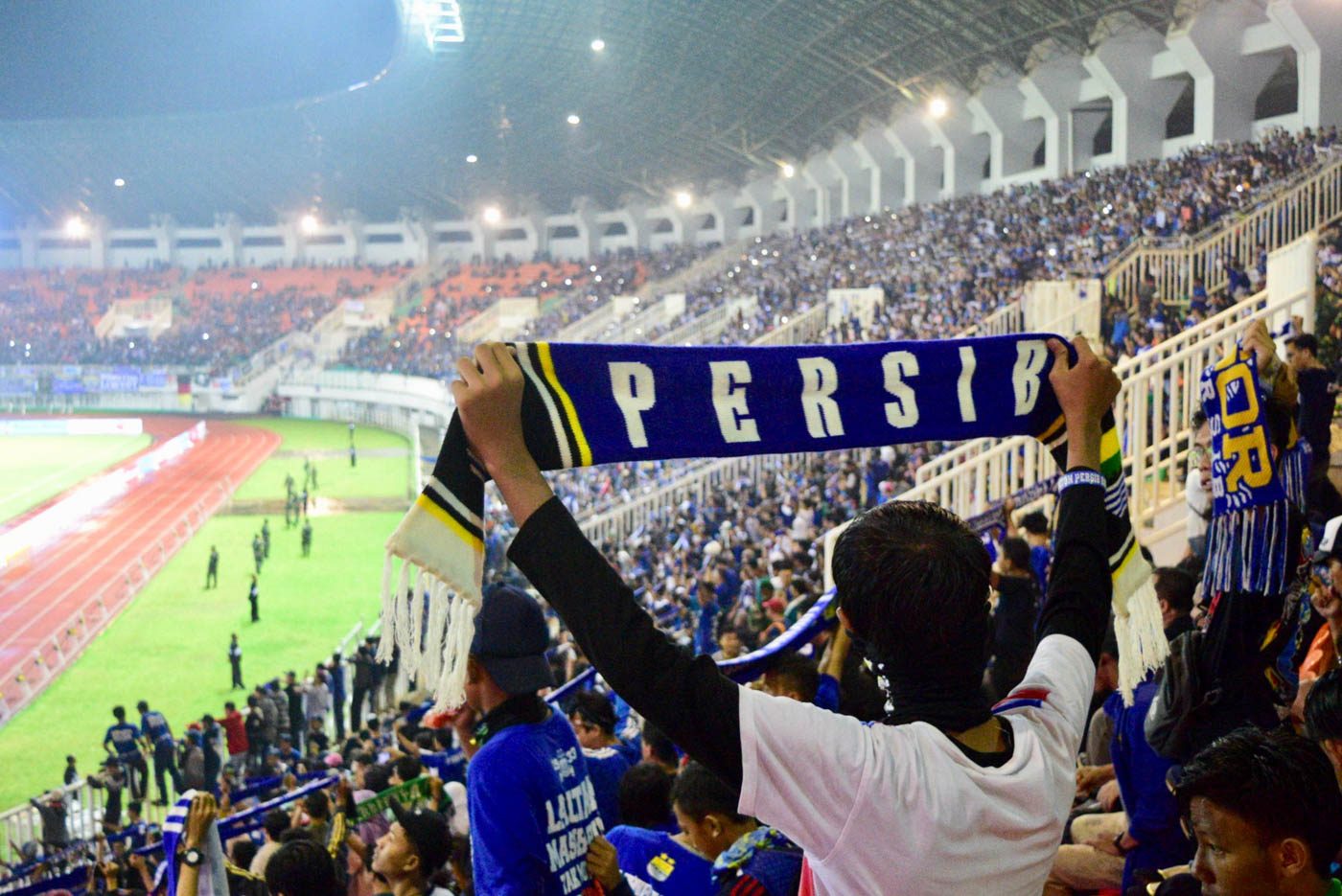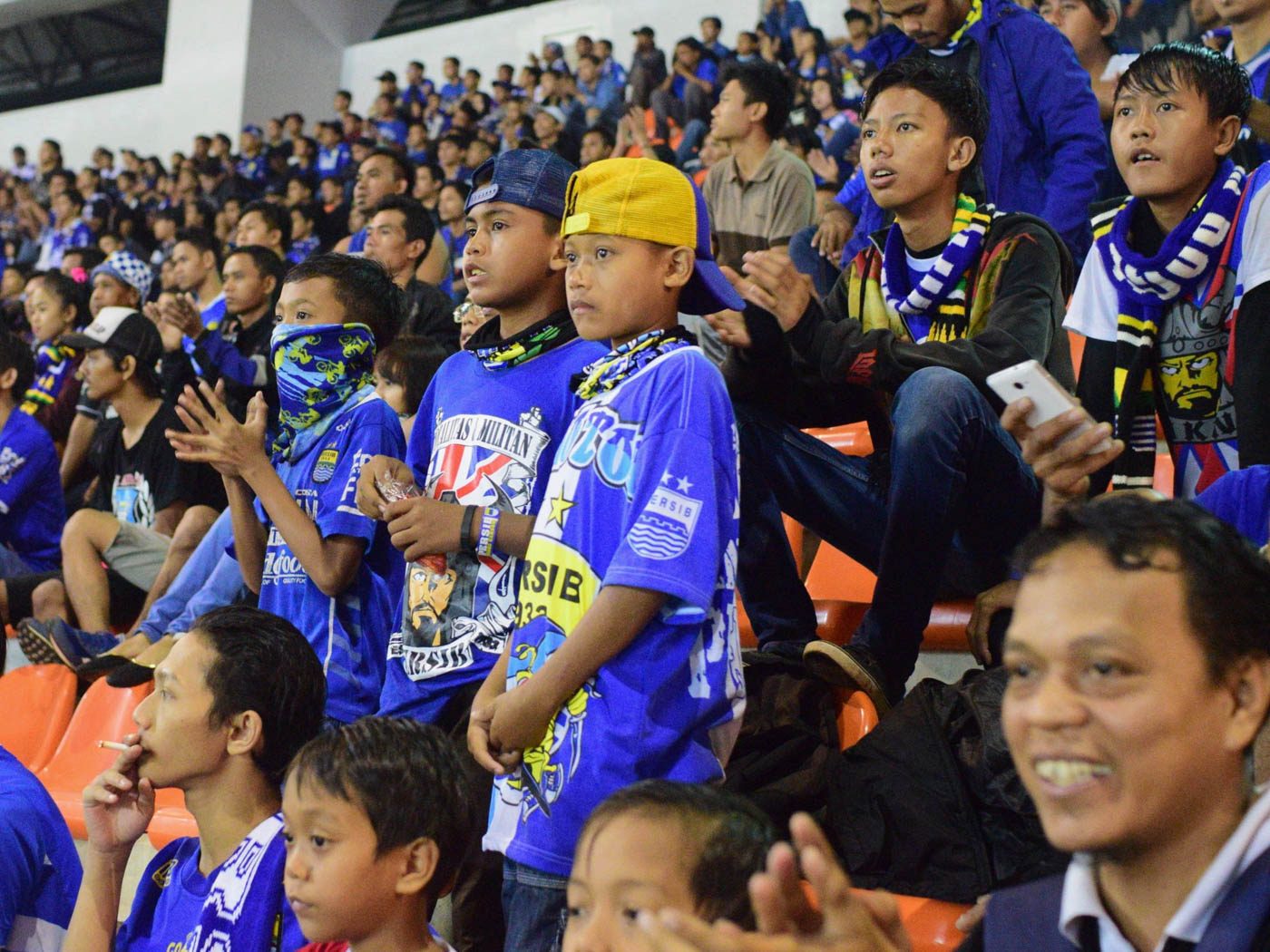SUMMARY
This is AI generated summarization, which may have errors. For context, always refer to the full article.

It’s an overcast Saturday afternoon as we wind through the narrow secondary roads of Jakarta’s suburbs in an Uber towards the town of Bogor, West Java. I’m with Welly Tarigan, a cousin of my sister’s Indonesian husband, and a diehard Inter Milan supporter as well who has always admired one of the giants of Indonesian club football: Persib Bandung.
The car turns off Jalan Tegar Beriman into the access road that leads to Stadion Pakansari, where Persib is set to face off against PS TNI in the Indonesian top tier. Even at the corner, we spot stalls selling merchandise for Persib Bandung. They line the road all the way to the stadium. The shacks hawk knock-off jerseys, scarves, flags, viking hats and other trinkets.
We arrive at 4 pm and already throngs of Persib fans can be found, decked out in Persib’s royal blue. Then I discover that the game is kicking off at 6:30 pm, and that the 4:30 pm time I saw on the internet is just when the gates open.
We buy the cheapest “tribun” tickets for Rp70,000, or about P262, then after a pre-game snack of nasi goreng with chicken nuggets, and the purchase of a Persib scarf, we make our way into the stadium an hour before kickoff.
The logistics of entering the stadium are chaotic. Welly tells me that security wants to stop fans who don’t have tickets from entering, so they crack open the gates in intervals, letting in spectators in batches. We need to show our tickets in the air and after some jostling and shoving, we are in. We pass a drunken Persib supporter on the ground, surrounded by security personnel, and take our seats.
Pakansari seats 30,000, and about half were filled with Persib Bandung fans, 90% of which are wearing some kind of Persib jersey or fan shirt. TNI is the team of the Indonesian army, and small cadre of supporters, all uniformed servicemen, occupy one corner of the stadium, which played host to the Suzuki Cup semis and finals last December.
Yes, only half of the stadium was filled, but Persib is the away team in this fixture against a new TNI squad still out to gather fans. Bandung is 135 kilometers away.
The cheering for Persib’s rabid fans, known as the Bobotoh, is well-orchestrated and loud. They also have adopted the Viking clap of the Iceland national team, which they execute before kickoff.
At 6:30 pm the whistle blows and the game is underway.
* * *
“Indonesian football is very strange,” says Indonesian football agent Zo Genardo over a steaming plate of “iga,” or beef ribs at an Indonesian restaurant in a Jakarta suburb.
“Every single part of Indonesian football has politics,” he continues. “Even grassroots. It’s scary.”
Genardo says that 70-80% of Indonesian politicians use the game to help get elected. He also claims the governing body of Indonesian football, the Persatuan Sepakbola Seluruh Indonesia, or PSSI, functions more like a political party than a sports authority.
Disunity and infighting have been hallmarks of Indonesian football. Things reached a nadir on May 30, 2015 when FIFA suspended the country from all forms of international football. Two rival leagues, questions about the eligibility of two clubs to play in them, and government interference in the matter, (a FIFA no-no), led to the sanction. Because of it, Indonesia’s national team was unable to participate in World Cup qualifying and its clubs barred from joining the AFC Cup. The ban was lifted a year later.
PSSI has also been involved in other dubious matters, like when unfashionable Persipura Jayapura from West Papua was unable to join the AFC Cup despite being the league champs. The reason? The PSSI forgot to accomplish the paperwork, according to Genardo. There is another worrying trait of Indonesian club football that may seem all too familiar.
“Indonesians only want shortcuts to success. That is the mentality,” adds Genardo.
Typically Indonesian clubs have only operated U19 teams under their senior sides, but none in younger age groups, according to Genardo. It is only now that clubs are developing youth academies. Clubs presumably recruit talented players from the countryside instead of molding them themselves.
Because of this system, a hole exists in the development of players from ages 16 to 20. At that age Indonesian players lack match experience and good coaching, thus preventing them from reaching their full potential. That might explain why a football-addled nation of 250 million people has never come close to qualifying for the final stage of a FIFA World Cup. (They did play in one round of the 1938 World Cup as the Dutch East Indies, falling to Hungary 6-0.)
Genardo estimates there are only 60 to 70 “A” license coaches in Indonesia, only 3-4 times more than the number of “A” license mentors in the Philippines. That seems disproportionate considering the difference in football fervor between the two countries.
To its credit Indonesian football seems to have reorganized well since the ban was lifted. There is now a unified three-tier league pyramid under the auspices of the federation. Matches are well-attended and draw big TV ratings.
But the country still punches below its weight, according to Rappler Indonesia football contributing writer Agung Iskandar.
“Indonesia is a football country. But in terms of management, it seems much more disaster than achievement (sic).”
* * *
After 45 minutes, TNI and Persib are where they began, at 0-0. The military side shows quality on the wings but cannot convert. Bandung has hit the woodwork but the back of the net eludes them.
The air in the stadium is redolent of Indonesian clove cigarettes, as a greyish fog settles below the roof. Yes, they allow smoking in Indonesian club football, and many fans, including teenagers, can be seen puffing away on Gudang Garams while taking in the game. De La Salle coach Hans Smit, infamous for lighting up during matches and born in Depok, about 40 minutes away, would feel very much at home.
The second half brings a surge of hope within the Bobotoh faithful. Coming into the game as a second half sub is none other than Chelsea legend Michael Essien.
The attacking midfielder is in Indonesia after departing the Blues in 2014 and suiting up for AC Milan and Panathinaikos. At 34 years old, he is no longer the dynamo he used to be, but he impresses in Persib blue just as he did in the same color for Chelsea. Essien’s vision and passing touch result in some threatening sorties, and eventually, a breakthrough. The Ghanaian rises above the TNI defense to nod home an opener. The roof of the stadium just about manages to stay put as the Bandung faithful go bonkers. It’s his first Persib goal.
Moments later, Persib go 2-0 with a lovely volley from captain Atep Rizal. The Bobotoh go berserk once again. The match seems to be in control with around 20 minutes to go.
* * *
As the Philippines embarks on it’s own fully professional, national competition, the Philippines Football League, what lessons can be learned from the Indonesian experience? Quite a few.
Youth. There were hordes of youngsters at the Persib-TNI match. My companion Welly even noticed 3 kids who couldn’t have been more than ten years old, watching the game in full Persib regalia. They appeared to be unaccompanied by any adult or older kids. There were also young children with their parents and lots of teens.
Lifelong fandom begins at an early age. Both teams and the PFL need to recognize this and market to children. Family ticket packages and free or discounted admission for young children will also help. Marketing campaigns should also be directly targeted to kids.
Unlike Indonesian clubs in the past, Filipino clubs also need to invest in youth football. Fortunately it’s mandatory that PFL clubs have youth programs.
Sustainability. Financially, Indonesian clubs have traditionally suckled at the teat of provincial governments’ udders. But that practice is being stopped by the government, and now clubs must get funding from the private sector. With 18 clubs in the top tier and 60 more in the second, Indonesian clubs appear to be managing the transition reasonably well.
It has been a brave move by the powers-that-be to ask teams to go it alone. But in the long run it could compel teams to be more professional, accountable, and better-managed.
The Philippines Football League and its clubs should also work towards sustainability as its goal. They must spend prudently and try to maximize revenue streams. The league must reach out to sponsors and be creative. Case in point: the Indonesian top-tier has not one, but two title sponsors. It’s called the Gojek Traveloka Liga 1. Gojek is a motorcycle ride-sharing service and Traveloka a flight-booking website.
Politics. In an ideal world, those involved in football administration are in it for the love of the game. Political appointees should be minimized. And those in leadership must see the biggest picture and the longest view in order to help the game forward. A feel for marketing and promotion is also crucial.

The sort of balkanization that led to Indonesia’s FIFA suspension should never happen in Philippine football.
Regionalism. Persib represents the Sundanese ethnolinguistic group that is centered in the West Javan capital of Bandung. However there are plenty of Sundanese scattered all over Java who still cheer for the “Maung Bandung,” or Bandung tiger. Banners of the different Persib supporters groups from all over Java can be seen draped on the railings at the stadium in the game against TNI.
Persib’s bitterest rival is Persija Jakarta, the club of another ethnolinguistic group, the Betawi. The enmity between the two supporters is long-standing and at times lethal. Their derby matches are heated and played in front of huge crowds.
Welly tells me of a time when Persija’s diehard fans, collectively known as the Jakmania, attacked a convoy of buses containing traveling Persib supporters. That in itself isn’t even remarkable. What is unusual is that the Persib wasn’t even playing Persija, but were on their way to Palembang to play Sriwijaya in a Cup final. Such is the passion. Misplaced passion, perhaps, but passion nonetheless.
These teams represent tribes, and tend to recruit their players from within their communities. It will be tough for PFL clubs to do this initially, but an effort should be made. It can only help to strengthen the bond between the team and its city or province.
If I were Davao Aguilas FC I would try to get the best players from both Davao and Mindanao. I’d also market the team to all Mindanaoans just to broaden the fanbase.
Patience. The big clubs like Persib, Persija, did not become popular overnight. Persib’s progenitor, called the Bandoeng Inlandsche Voetbal Bond, was founded in 1933 and Persija five years earlier. It takes generations for a team to be ingrained into the local community and for a rabid fan culture to emerge. So the PFL must plant seeds now and hope to harvest fruit later on.
* * *
Despite leading 2-0, victory is denied Persib Bandung and their faithful. Astonishingly, Persib concedes two late TNI strikes and the game finishes 2-2. The soldiers celebrate joyously while the stunned Bobotoh put hands on heads as the final whistle sounds. The Persib fans give their heroes one last Viking clap cheer anyway.
So much promise and potential frittered away. A microcosm of Indonesian club football perhaps? Let’s hope the Philippines Football League avoids a similar fate. – Rappler.com
Any reactions? Please feel free to express them to me on Twitter @PassionateFanPH.
Add a comment
How does this make you feel?
There are no comments yet. Add your comment to start the conversation.